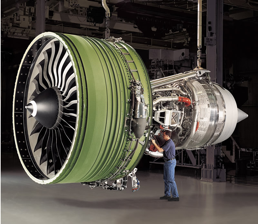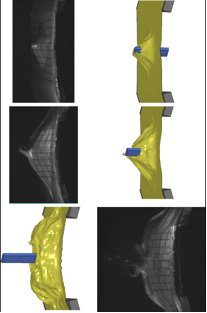Composite Fabrics for Jet Engine Containment Systems
Project Sponsor: Federal Aviation Administration, AACE Grant for Centers of Excellence.
Composite fiber fabric wraps are widely used in the containment systems of aircraft gas turbine engines. Such systems are essential as they mitigate engine debris during a fan blade-out event which is defined as failure of a fan blade and release of the kinetic energy associated with its interaction with engine and fuselage components. Woven dry fabrics are ideal containment systems as they have a high strength per unit weight. Moreover, it is inexpensive to manufacture such a containment system compared with the traditional metallic systems. To properly utilize this advantage, it is necessary to have a robust finite element analysis modeling methodology for design tasks. Modeling a multi-layer fabric composite for engine containment systems during a fan blade-out event has been a difficult task since the constitutive properties and the sequence of events during the impact need to be better defined and modeled. This project has been addressing the components of experimental and theoretical modeling of these phenomena.


Comparison between simulation and experimental deformation patterns for turbine blade containment system
- “Explicit Finite Element Analysis Modeling of Multi-Layer Composite Fabric for Gas Turbine Engines Containment Systems Part 1- Static Tests and Modeling,” S. D. Rajan, Barzin Mobasher, Jignesh Sharda, Venkat Yanna, Chaitanya Deenadaylu, David Lau and Dhaval Shah, Final report, DOT/FAA/AR-04/40,P1 Office of Aviation Research, Washington, D.C. 20591, 115 pages, November 2004. [download]
- S.D. Rajan, B. Mobasher, S. Sankaran, D. Naik, and Z. Stahlecker, “Explicit Finite Element Modeling of Multilayer Composite Fabric for Gas Turbine Engine Containment Systems, Phase II, Part 1: Fabric Material Tests and Modeling,” DOT/FAA/AR-08/37,P1, Office of Aviation Research, Washington, D.C. February 2009. [download]
- S.D. Rajan, B. Mobasher, Z. Stahlecker, S. Bansal, D. Zhu, M. Morea and K. Dhandapani. LS-DYNA Implemented Multi-Layer Fabric Material Model Development for Engine Fragment Mitigation. Phase 3 Final Report, Office of Aviation Research, Wash, D.C., 2009.
- Sharda, J., Deenadayalu, C., Mobasher, B., and Rajan S. D., “Modeling of Multi-Layer Composite Fabrics for Gas Turbine Engine Containment Systems,”, ASCE Journal of Aerospace Engineering, Vol. 19, No. 1, 2006. pp. 38-45. [download]
- D. Naik, S. Sankaran, B. Mobasher and S. D. Rajan, and J.M. Pereira, “Development of Reliable Modeling Methodologies for Fan Blade-Out Containment Analysis. Part I: Experimental Studies,” International Journal of Impact Engineering, 36 (2009), International Journal of Impact Engineering, Volume 36, Issue 1, January 2009, Pages 1-11 doi:10.1016/j.ijimpeng.2008.03.007 [download]
- Z. Stahlecker, S. Sankaran, B. Mobasher and S. D. Rajan, and J.M. Pereira, “Development of Reliable Modeling Methodologies for Fan Blade-Out Containment Analysis. Part II: Finite Element Analysis” International Journal of Impact Engineering, Volume 36, Issue 3, March 2009, Pages 447-459. [download]
- D. Zhu, B. Mobasher, S.D. Rajan, “Dynamic Tensile Testing of Kevlar 49® Fabrics,” ASCE Journal of Materials in Civil Engineering, in review, 2008.
- Deju Zhu, Barzin Mobasher*, S.D.Rajan, and Pedro Peralta. Characterization of Dynamic Tensile Testing using Aluminum Alloy 6061-T6 at Intermediate Strain Rates. ASCE Journal of Engineering Mechanics (in review), 2009.
- S. Bansal; B. Mobasher; S. D. Rajan; and I. Vintilescu, “Development of Fabric Constitutive Behavior for Use in Modeling Engine Fan Blade-Out Events” Journal of Aerospace Engineering, ASCE, Journal of Aerospace Engineering, Vol. 22, No. 3, July, 2009. p. 249-259. [download]